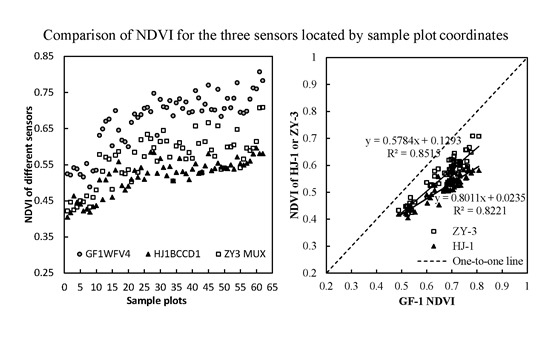Comparative Analysis of GF-1 WFV, ZY-3 MUX, and HJ-1 CCD Sensor Data for Grassland Monitoring Applications
Abstract
:1. Introduction
2. Materials
2.1. Study Sites
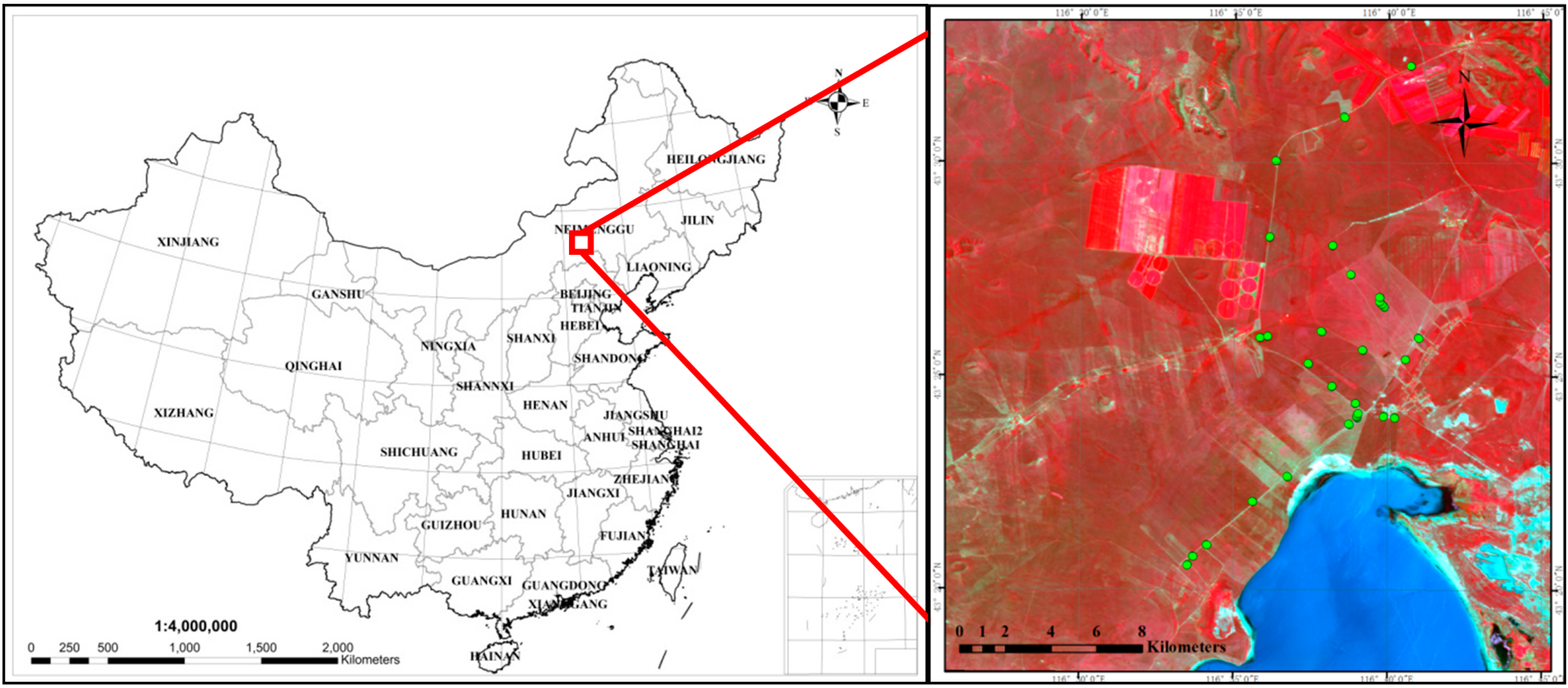
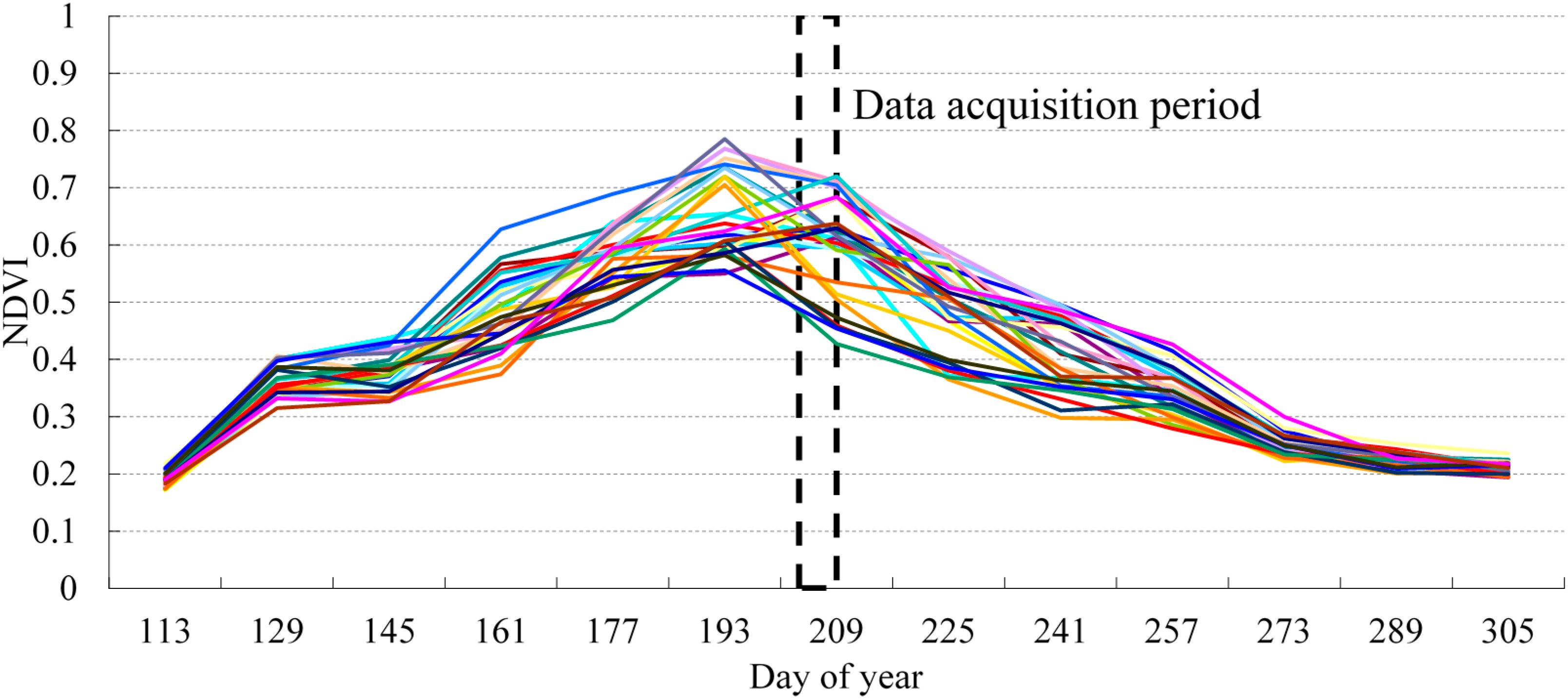
2.2. Sampling Plot Settings
2.3. Hyperspectral Reflectance Field Measurements
2.4. LAI and Vegetation Coverage Field Measurements

2.5. Remote Sensing Image Acquisition
| Sensor | Revisitation Period (d) | Spatial Resolution (m) | Breadth (km) | Radiometric Resolution (Bit) | Band 1 (nm) | Band 2 (nm) | Band 3 (nm) | Band 4 (nm) |
|---|---|---|---|---|---|---|---|---|
| GF-1 WFV | 4 | 16 | 200 (1CCD) | 10 | 0.45–0.52 | 0.52–0.59 | 0.63–0.69 | 0.77–0.89 |
| 800 (4CCD) | ||||||||
| HJ-1 CCD | 4 | 30 | 360 (1CCD) | 8 | 0.41–0.52 | 0.52–0.60 | 0.63–0.69 | 0.76–0.90 |
| 700 (2CCD) | ||||||||
| ZY-3 MUX | 5 | 5.8 | 52 | 10 | 0.45–0.52 | 0.52–0.59 | 0.63–0.69 | 0.77–0.89 |
| Sensor | Date | Time/UTC | SOLAR Zenith Angle (°) | Solar Azimuth Angle (°) | Sensor Zenith Angle (°) | Sensor Azimuth Angle (°) |
|---|---|---|---|---|---|---|
| GF1-WFV | 2013-7-30 | 03 h 42 min | 26.1747 | 158.4 | 54.0402 | 286.6640 |
| HJ-1 CCD | 2013-7-28 | 02 h 41 min | 33.036 | 132.348 | 16.7984 | 283.5116 |
| ZY3-MUX | 2013-7-28 | 03 h 19 min | 27.5188 | 147.628 | 6.3623 | 11.1373 |
3. Methods
3.1. Remote Sensing Image Processing
3.1.1. Atmospheric Correction
3.1.2. Geometric Correction
3.2. Computing Band Reflectance Based on the Spectral Response Function (SRF)
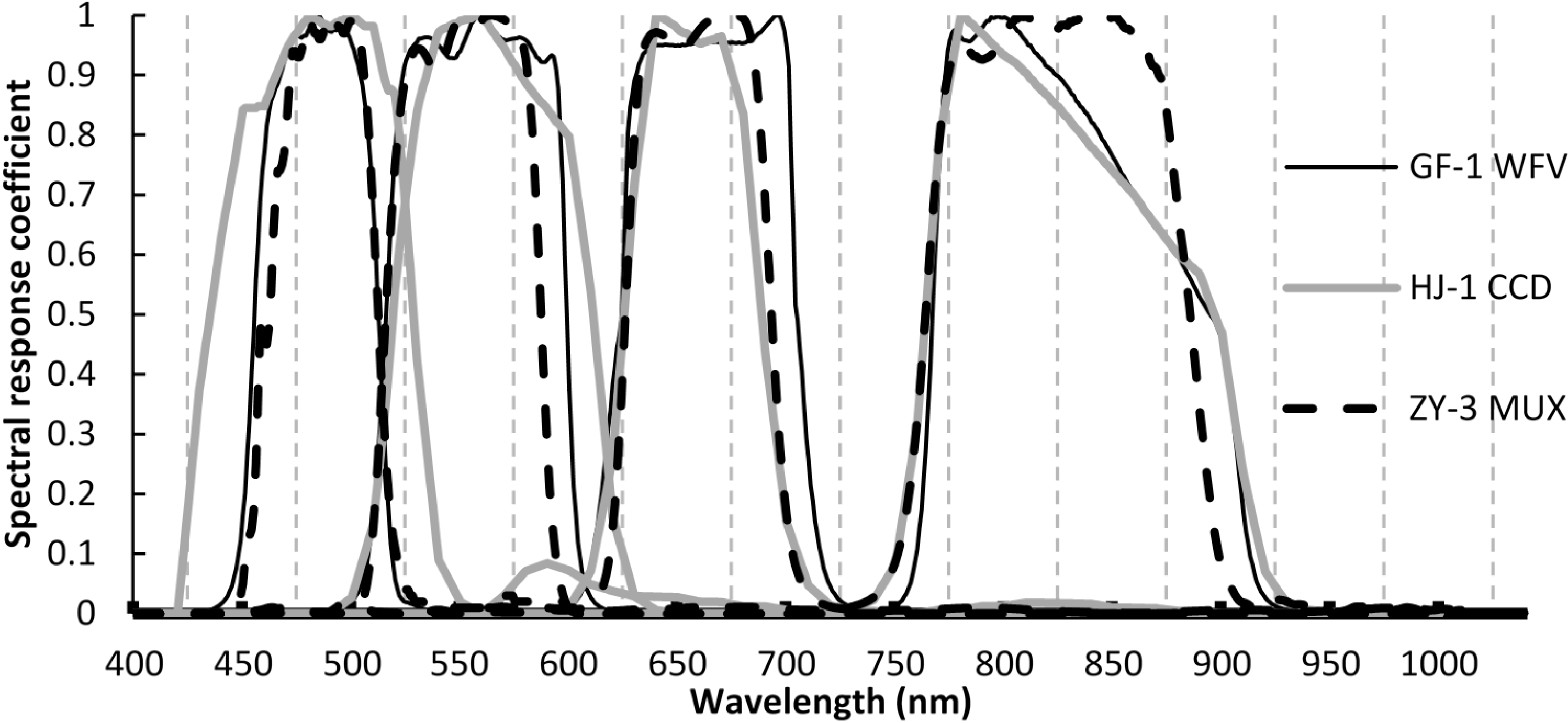
3.3. Vegetation Index
3.4. Simulations with PROSAIL
3.5. Data Analysis
4. Comparative Analysis of Different Sensors’ Data
4.1. Reflectance of Red and Near-Infrared Bands
4.2. NDVI
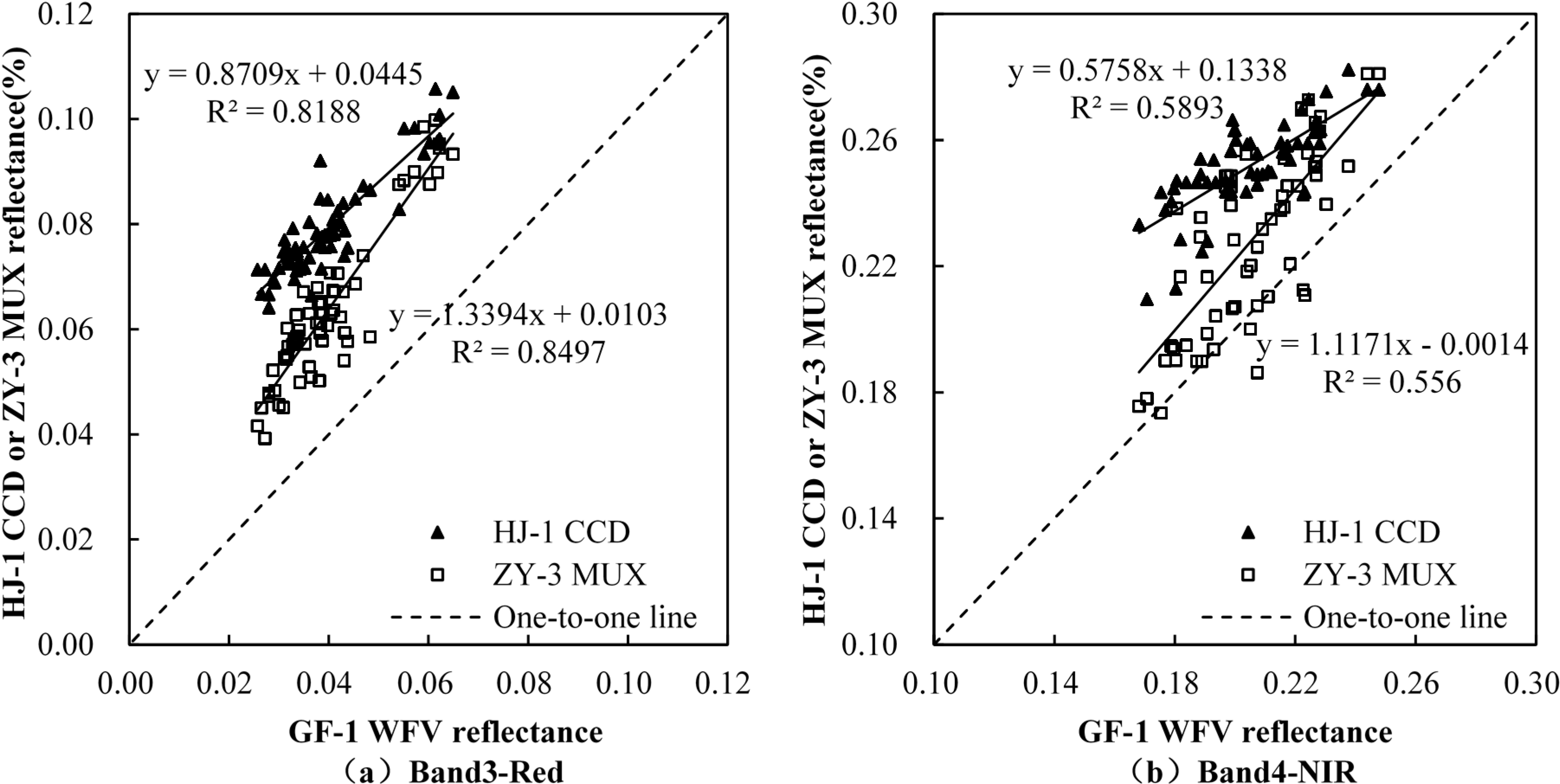
| Band 3 (Red) | Band 4 (NIR) | NDVI | |||||||
|---|---|---|---|---|---|---|---|---|---|
| GF-1 WFV | HJ-1 CCD | ZY-3 MUX | GF-1 WFV | HJ-1 CCD | ZY-3 MUX | GF-1 WFV | HJ-1 CCD | ZY-3 MUX | |
| GF-1 WFV | 1 | 1 | 1 | ||||||
| HJ-1 CCD | 0.8188 | 1 | 0.5893 | 1 | 0.8221 | 1 | |||
| ZY-3 MUX | 0.8497 | 0.7492 | 1 | 0.5560 | 0.4401 | 1 | 0.8515 | 0.7576 | 1 |
| Sensor | Band 3 (Red) | Band 4 (NIR) | NDVI | |||||||||
|---|---|---|---|---|---|---|---|---|---|---|---|---|
| Max | Min | Mean | Std. Dev | Max | Min | Mean | Std. Dev | Max | Min | Mean | Std. Dev | |
| GF-1 WFV | 0.065 | 0.026 | 0.040 | 0.010 | 0.248 | 0.168 | 0.206 | 0.019 | 0.807 | 0.488 | 0.675 | 0.078 |
| HJ-1 CCD | 0.106 | 0.064 | 0.079 | 0.010 | 0.282 | 0.210 | 0.252 | 0.014 | 0.596 | 0.405 | 0.520 | 0.049 |
| ZY-3 MUX | 0.100 | 0.039 | 0.064 | 0.015 | 0.281 | 0.173 | 0.229 | 0.028 | 0.708 | 0.422 | 0.564 | 0.069 |
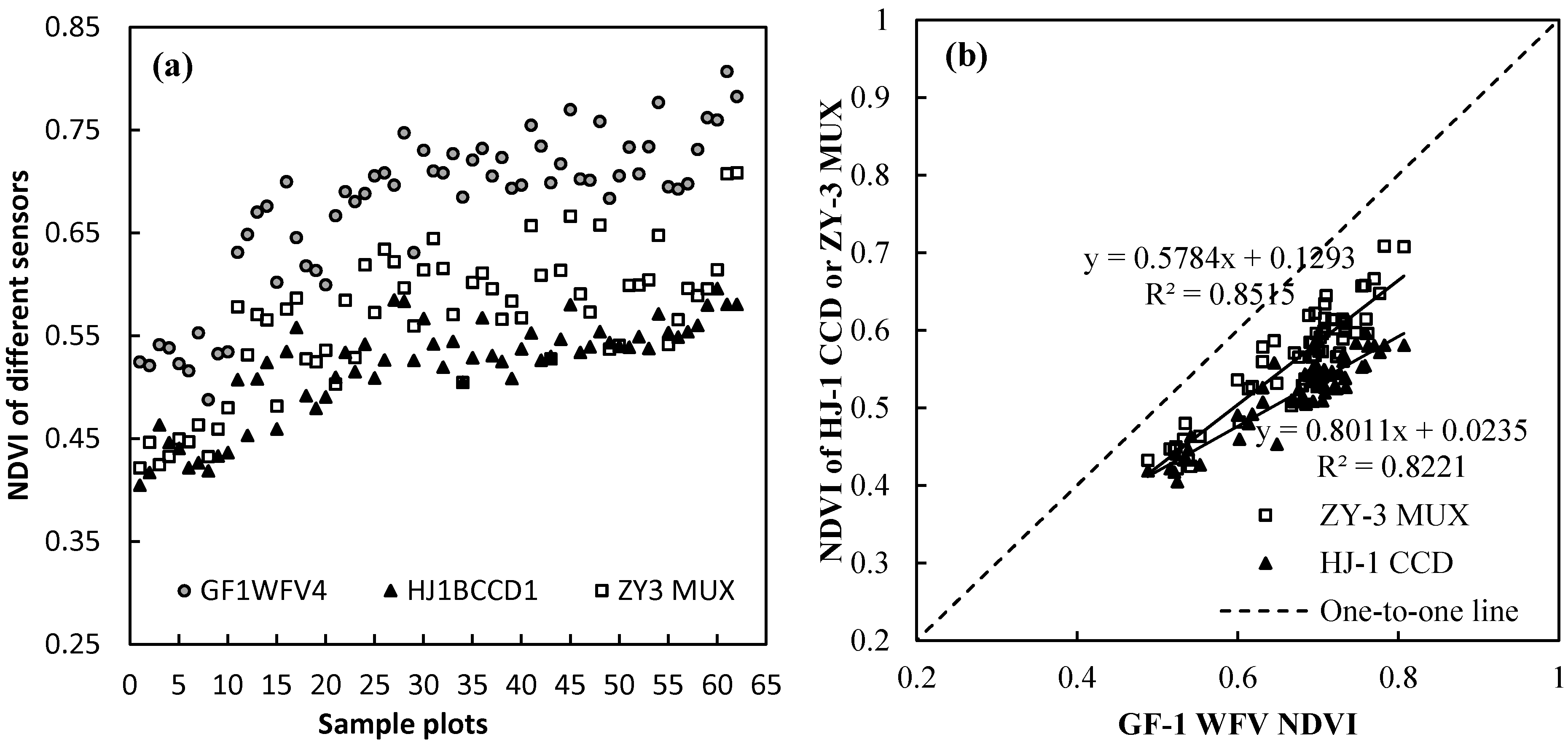
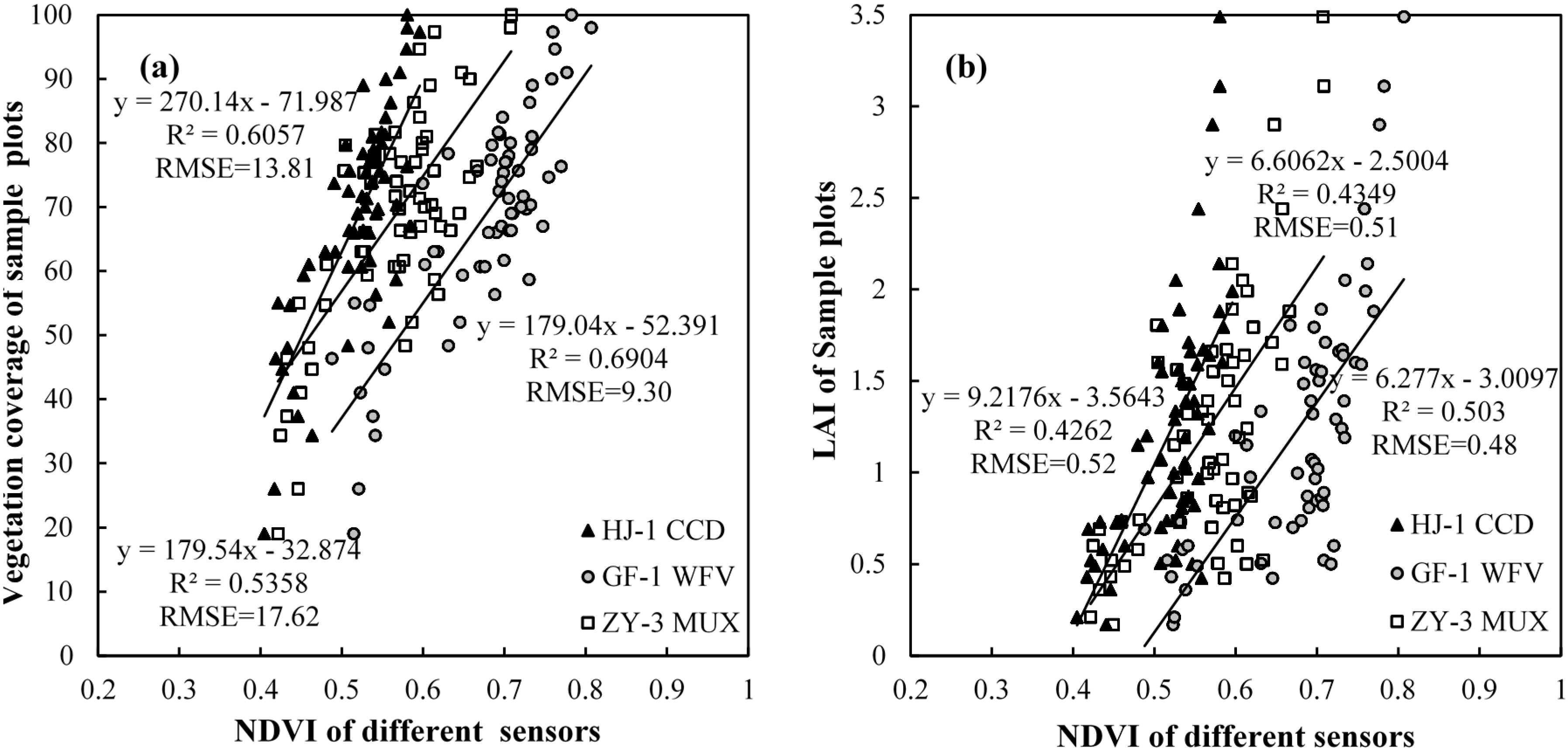
4.3. Correlations of Grassland Coverage or LAI and NDVI of Different Sensors
5. Effect Factors Analysis for Discrepancies among the Three Sensors
5.1. Effects of the Spectral Response Function on Band Reflectance
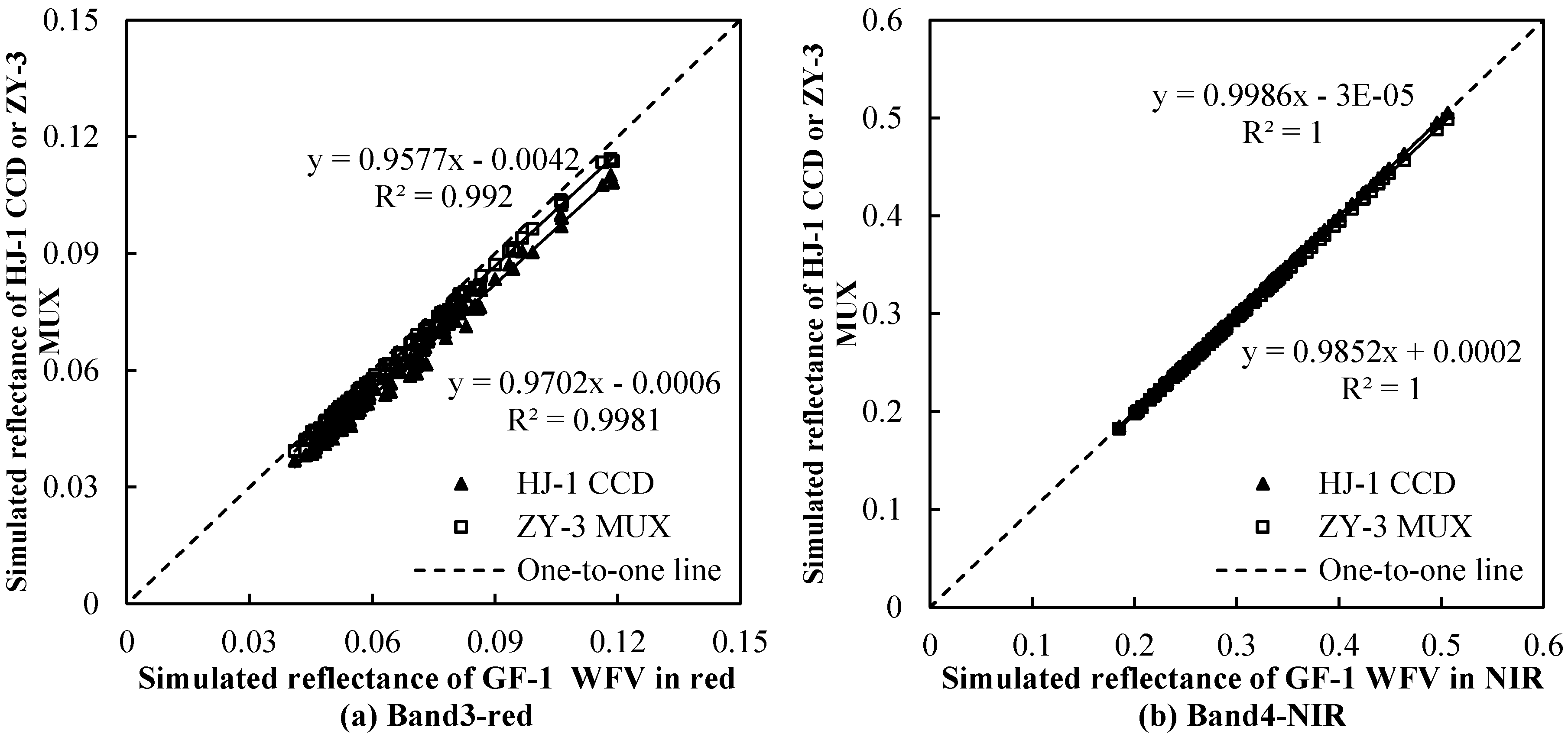
| Band 3 (Red) | Band 4 (NIR) | NDVI | |||||||
|---|---|---|---|---|---|---|---|---|---|
| GF-1 WFV | HJ-1 CCD | ZY-3 MUX | GF-1 WFV | HJ-1 CCD | ZY-3 MUX | GF-1 WFV | HJ-1 CCD | ZY-3 MUX | |
| GF-1 WFV | 1 | 1 | 1 | ||||||
| HJ-1 CCD | 0.9981 | 1 | 1.0000 | 1 | 0.9988 | 1 | |||
| ZY-3 MUX | 0.9920 | 0.9961 | 1 | 1.0000 | 1.0000 | 1 | 0.9985 | 0.9999 | 1 |
5.2. Effects of the Spectral Response Function on NDVI
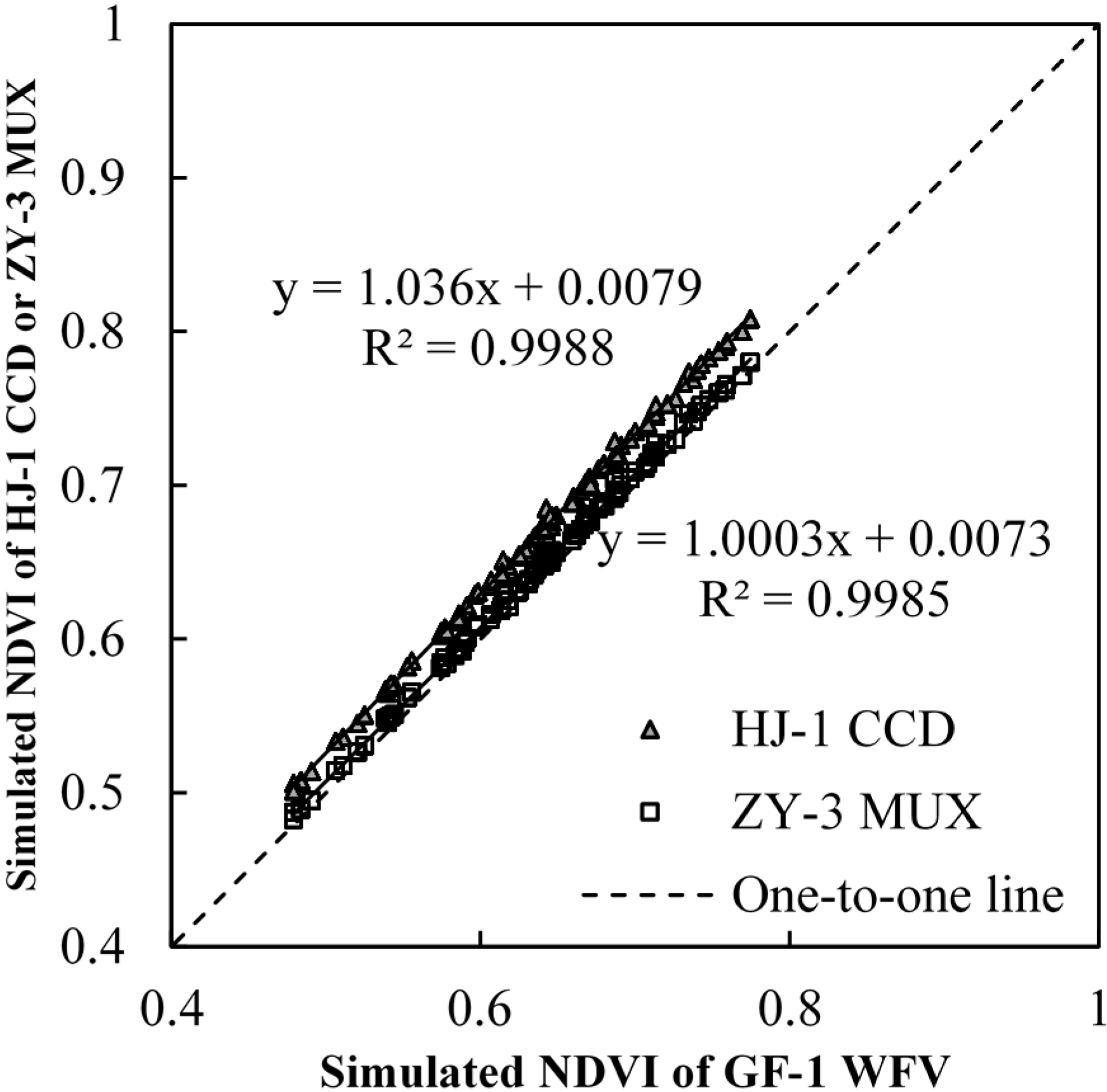
5.3. Effects of Sensors’ Zenith Angle Changes Caused by Side Sway on NDVI
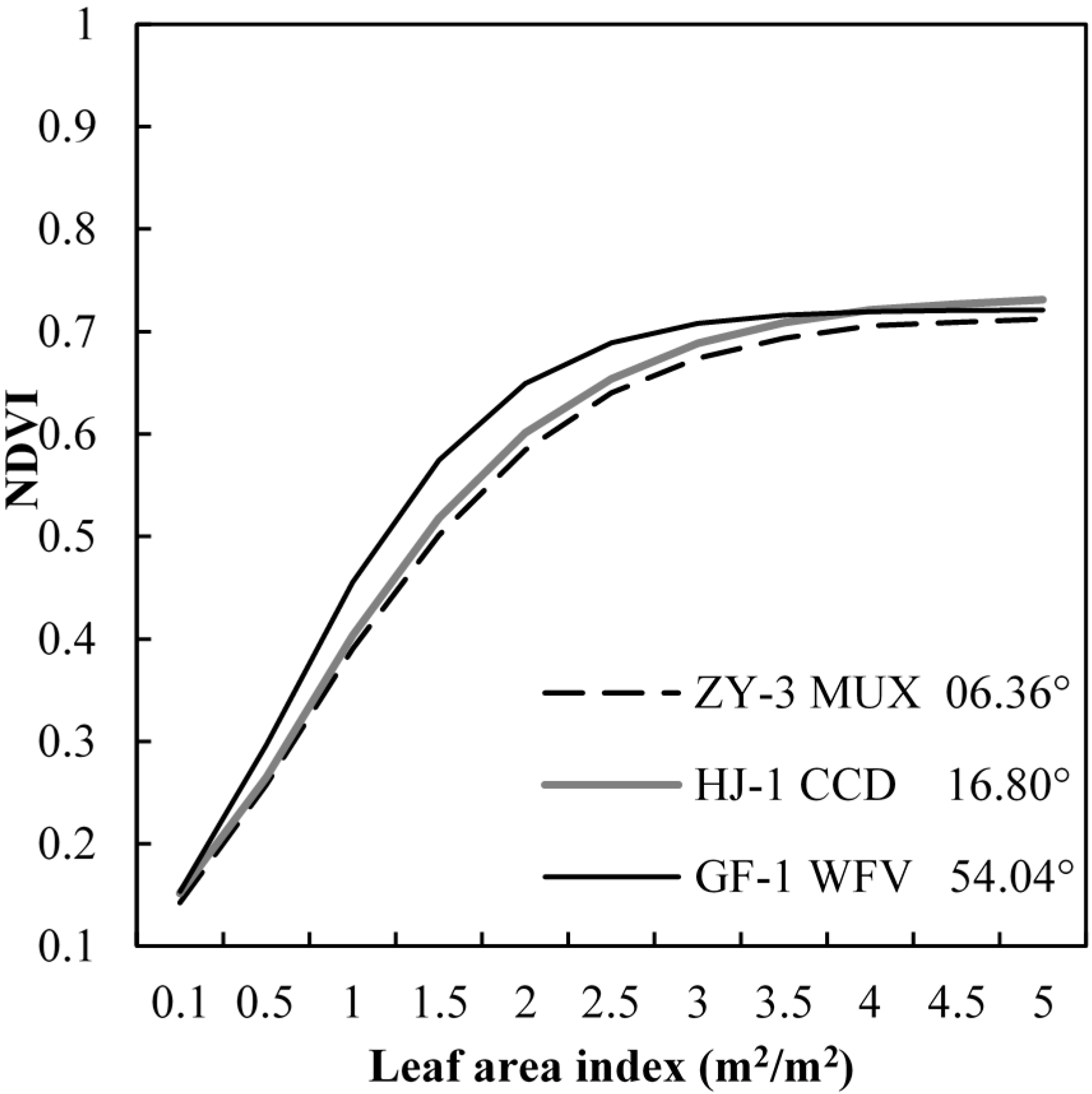
6. Discussion
7. Conclusions
Acknowledgments
Author Contributions
Conflicts of Interest
References
- Scurlock, J.; Hall, D. The global carbon sink: A grassland Perspective. Glob. Chang. Biol. 1998, 4, 229–233. [Google Scholar] [CrossRef]
- Xu, P. Grassland Resources Investigation and Planning Science; China Agriculture Press: Beijing, China, 2000. [Google Scholar]
- Chen, J.; Cihlar, J. Retrieving leaf area index of boreal conifer forests using Landsat TM images. Remote Sens. Environ. 1996, 55, 153–162. [Google Scholar] [CrossRef]
- Fang, H.; Liang, S. Retrieving leaf area index with a neural network method: Simulation and validation. IEEE Trans. Geosci. Remote Sens. 2003, 41, 2052–2062. [Google Scholar] [CrossRef]
- Anaya, J.A.; Chuvieco, E.; Palacios-Orueta, A. Aboveground biomass assessment in Colombia: A remote sensing approach. For. Ecol. Manag. 2009, 257, 1237–1246. [Google Scholar] [CrossRef]
- Brantley, S.T.; Zinnert, J.C.; Young, D.R. Application of hyperspectral vegetation indices to detect variations in high leaf area index temperate shrub thicket canopies. Remote Sens. Environ. 2011, 115, 514–523. [Google Scholar] [CrossRef]
- Tillack, A.; Clasen, A.; Kleinschmit, B.; Förster, M. Estimation of the seasonal leaf area index in an alluvial forest using high-resolution satellite-based vegetation indices. Remote Sens. Environ. 2014, 141, 52–63. [Google Scholar] [CrossRef]
- Gallo, K.P.; Daughtry, C.S.T. Differences in vegetation indices for simulated Landsat-5 MSS and TM, NOAA-9 AVHRR, and SPOT-1 sensor systems. Remote Sens. Environ. 1987, 23, 439–452. [Google Scholar] [CrossRef]
- Teillet, P.M.; Staenz, K.; Williams, D.J. Effects of spectral spatial and radiometric characteristics of remote sensing vegetation indices of forested regions. Remote Sens. Environ. 1997, 61, 139–149. [Google Scholar] [CrossRef]
- Soudani, K.; François, C.; le Maire, G.; le Dantec, V.; Dufrêne, E. Comparative analysis of IKONOS, SPOT, and ETM+ data leaf area index estimation in temperature coniferous and deciduous forest stands. Remote Sens. Environ. 2006, 102, 161–175. [Google Scholar] [CrossRef]
- Li, L.; Gu, X.F.; Ye, Z.T.; Yu, T.; Qiao, Y.L.; Meng, Q.Y.; Wang, Y.X. Characteristic difference analysis and transfer parameter determination for different satellites to detect NDVI values. Sci. China Earth Sci. 2012, 42, 238–245. [Google Scholar]
- Li, P.; Jiang, L.G.; Feng, Z.M. Cross-comparison of vegetation Indices derived from Landsat-7 enhanced Thematic Mapper Plus (ETM+) and Landsat-8 Operational Land Imager (OLI) sensors. Remote Sens. 2014, 6, 310–329. [Google Scholar] [CrossRef]
- Goward, S.N.; Davis, P.E.; Fleming, D.; Miller, L.; Townshend, J.R. Empirical comparison of Landsat 7 and IKONOS multispectral measurements for selected Earth Observation System (EOS) validation sites. Remote Sens. Environ. 2003, 88, 80–99. [Google Scholar] [CrossRef]
- Thenkabail, P.S.; Enclona, E.A.; Ashton, M.S.; Legg, C.; Jean de Dieu, M. Hyperion, IKONOS, ALI, and ETM+ sensors in the study of African rainforests. Remote Sens. Environ. 2004, 90, 23–43. [Google Scholar] [CrossRef]
- Van Leeuwen, W.J.D.; Orr, B.J.; Marsh, S.E.; Herrmann, S.M. Multi-sensor NDVI data continuity: Uncertainties and implications for vegetation monitoring applications. Remote Sens. Environ. 2006, 100, 67–81. [Google Scholar] [CrossRef]
- Xu, H.Q.; Zhang, T.J. Cross-comparison of ASTER and Landsat ETM+ multispectral Measurements for NDVI and SAVI vegetation indices. Spectrosc. Spect. Anal. 2011, 31, 1902–1907. [Google Scholar]
- Gao, H.L.; Gu, X.F.; Yu, T.; Gong, H.; Li, J.G. Method study and uncertainty analysis of calibration coefficients validation based on the Inner Mongolia test site. Sci. China Earth Sci. 2013, 43, 287–294. [Google Scholar]
- Hmiminaa, G.; Dufrênea, E.; Pontaillera, J.-Y.; Delpierrea, N.; Aubinetb, M.; Caquetd, B.; de Grandcourtd, A.; Burbane, B.; Flechardf, C.; Granierc, A.; et al. Evaluation of the potential of MODIS satellite data to predict vegetation phenology in different biomes: An investigation using ground-based NDVI measurements. Remote Sens. Environ. 2013, 132, 145–158. [Google Scholar] [CrossRef]
- Chen, J.M.; Black, T.A.; Adams, R.S. Evaluation of hemispherical photography for determining plant area index and geometry of a forest stand. Agric. For. Meteorol. 1991, 56, 129–143. [Google Scholar] [CrossRef]
- Darvishzadeh, R.; Atzberger, C.; Skidmore, A.; Schlerf, M. Mapping grassland leaf area index with airborne hyperspectral imagery: A comparison study of statistical approaches and inversion of radiative transfer models. ISPRS J. Photogramm. Remote Sens. 2011, 66, 894–906. [Google Scholar] [CrossRef]
- Hadjimitsis, D.G.; Clayton, C.R.I.; Hope, V.S. An assessment of the effectiveness of atmospheric correction algorithms through the remote sensing of some reservoirs. Int. J. Remote Sens. 2004, 25, 3651–3674. [Google Scholar] [CrossRef]
- China Center for Resources Satellite Data and Application. Landsat Introduction. Available online: http://www.cresda.com/n16/n1130/index.html (accessed on 6 January 2014).
- Myneni, R.B.; Hall, F.B.; Sellers, P.J.; Marshak, A.L. The interpretation of spectral vegetation indices. IEEE Trans. Geosci. Remote Sens. 1995, 33, 481–486. [Google Scholar] [CrossRef]
- Tucker, C.J. Red and photographic infrared linear combinations for monitoring vegetation. Remote Sens. Environ. 1979, 8, 127–150. [Google Scholar] [CrossRef]
- Huete, A.; Didan, K.; Miura, T.; Rodriguez, E.P.; Gao, X.; Ferreira, L.G. Overview of the radiometric and biophysical performance of the MODIS vegetation indices. Remote Sens. Environ. 2002, 83, 195–213. [Google Scholar] [CrossRef]
- Rouse, J.W.; Haas, R.H. Monitoring Vegetation Systems in the Great Plain with ERTS; NASA: Washington, DC, USA, 1973; Volume 1, pp. 309–317. [Google Scholar]
- Verhoef, W. Light scattering by leaf layers with application to canopy reflectance modeling: The SAIL model. Remote Sens. Environ. 1984, 16, 125–141. [Google Scholar] [CrossRef]
- Jacquemoud, S.; Baret, F. PROSPECT: A model of leaf optical properties spectra. Remote Sens. Environ. 1990, 34, 75–91. [Google Scholar] [CrossRef]
- Chlorophyll Meter SPAD-502; Minolta: Maarssen, The Netherlands, 2003.
- Markwell, J.; Osterman, J.C.; Mitchell, J.L. Calibration of Minolta SPAD-502 leaf chlorophyll meter. Photosynth. Res. 1995, 46, 467–472. [Google Scholar] [CrossRef] [PubMed]
- Darvishzadeh, R.; Skidmore, A.; Schlerf, M.; Atzberger, C. Inversion of a radiative transfer model for estimating vegetation LAI and chlorophyll in a heterogeneous grassland. Remote Sens. Environ. 2008, 112, 2592–2604. [Google Scholar] [CrossRef]
- Hawkins, T.; Gardiner, E.; Comer, G. Modeling the relationship between extractable chlorophyll and SPAD-502 readings for endangered plant species research. J. Nat. Conserv. 2009, 17, 123–127. [Google Scholar] [CrossRef]
- Zhao, D.; Huang, L.; Li, J.; Qi, J. A comparative analysis of broadband and narrowband derived vegetation indices in predicting LAI and CCD of a cotton canopy. ISPRS J. Photogramm. Remote Sens. 2007, 62, 25–33. [Google Scholar] [CrossRef]
- Heiskanen, J.; Rautiainen, M.; Stenberg, P.; Mõttus, M.; Vesanto, V. Sensitivity of narrowband vegetation indices to boreal forest LAI, reflectance seasonality and species composition. ISPRS J. Photogramm. Remote Sens. 2013, 78, 1–14. [Google Scholar] [CrossRef]
- Teillet, P.M.; Fedosejevs, G. On the dark target approach to atmospheric correction of remotely sensed data. Can. J. Remote Sens. 1995, 21, 374–387. [Google Scholar] [CrossRef]
- Epema, G.E. Atmospheric condition and its influence on reflectance of bare soil surfaces in southern Tunisia. Int. J. Remote Sens. 1992, 13, 853–868. [Google Scholar] [CrossRef]
- John, C.P. Calibration of satellite radiometers and the comparison of vegetation indices. Remote Sens. Environ. 1987, 21, 15–27. [Google Scholar] [CrossRef]
- Trishchenko, A.P.; Cihlar, J.; Li, Z. Effects of spectral response function on surface reflectance and NDVI measured with moderate resolution satellite sensors. Remote Sens. Environ. 2002, 81, 1–18. [Google Scholar] [CrossRef]
- Li, G.Q.; Li, X.B.; Li, G.M.; Wen, W.Y.; Wang, H.; Chen, L.H.; Yu, J.J.; Deng, F. Comparison of spectral characteristics between China HJ1-CCD and Landsat 5 TM imagery. IEEE J. Sel. Top. Appl. Earth Observ. Remote Sens. 2013, 6, 139–148. [Google Scholar] [CrossRef]
- Steven, M.D.; Malthus, T.J.; Baret, F.; Xu, H.; Chopping, M.J. Intercalibration of vegetation indices from different sensor systems. Remote Sens. Environ. 2003, 88, 412–422. [Google Scholar] [CrossRef]
- Nicodemus, F.E.; Richmond, J.C.; Hsia, J.J.; Ginsberg, W.I.; Limperis, T. Geometrical Considerations and Nomenclature for Reflectance; Institute for Basic Standards: Washington, DC, USA, 1977. [Google Scholar]
- Gao, F.; Schaaf, C.B.; Strahler, A.H.; Jin, Y.; Li, X. Detecting vegetation structure using a kernel-based BRDF Model. Remote Sens. Environ. 2003, 86, 198–205. [Google Scholar] [CrossRef]
- Pisek, J.; Ryu, Y.; Sprintsin, M.; He, L.M.; Oliphant, A.J.; Korhonen, L.; Kuusk, J.; Kuusk, A.; Bergstrom, R.; Verrelst, J.; et al. Retrieving vegetation clumping index from Multi-angle Imaging SpectroRadiometer (MISR) data at 275 m resolution. Remote Sens. Environ. 2013, 138, 126–133. [Google Scholar] [CrossRef]
- He, L.M.; Chen, J.M.; Pisek, J.; Schaaf, C.B.; Strahler, A.H. Global clumping index map derived from the MODIS BRDF product. Remote Sens. Environ. 2012, 119, 118–130. [Google Scholar] [CrossRef]
- Vermote, E.F.; Vermeulen, A. Atmospheric Correction Algorithm: Spectral Reflectances (MOD09) Version 4.0. Available online: http://modis.gsfc.nasa.gov/data/atbd/atbd_mod08.pdf (accessed on 10 February 2015).
© 2015 by the authors; licensee MDPI, Basel, Switzerland. This article is an open access article distributed under the terms and conditions of the Creative Commons Attribution license (http://creativecommons.org/licenses/by/4.0/).
Share and Cite
Wang, L.; Yang, R.; Tian, Q.; Yang, Y.; Zhou, Y.; Sun, Y.; Mi, X. Comparative Analysis of GF-1 WFV, ZY-3 MUX, and HJ-1 CCD Sensor Data for Grassland Monitoring Applications. Remote Sens. 2015, 7, 2089-2108. https://doi.org/10.3390/rs70202089
Wang L, Yang R, Tian Q, Yang Y, Zhou Y, Sun Y, Mi X. Comparative Analysis of GF-1 WFV, ZY-3 MUX, and HJ-1 CCD Sensor Data for Grassland Monitoring Applications. Remote Sensing. 2015; 7(2):2089-2108. https://doi.org/10.3390/rs70202089
Chicago/Turabian StyleWang, Lei, Ranran Yang, Qingjiu Tian, Yanjun Yang, Yang Zhou, Yuan Sun, and Xiaofei Mi. 2015. "Comparative Analysis of GF-1 WFV, ZY-3 MUX, and HJ-1 CCD Sensor Data for Grassland Monitoring Applications" Remote Sensing 7, no. 2: 2089-2108. https://doi.org/10.3390/rs70202089
APA StyleWang, L., Yang, R., Tian, Q., Yang, Y., Zhou, Y., Sun, Y., & Mi, X. (2015). Comparative Analysis of GF-1 WFV, ZY-3 MUX, and HJ-1 CCD Sensor Data for Grassland Monitoring Applications. Remote Sensing, 7(2), 2089-2108. https://doi.org/10.3390/rs70202089




